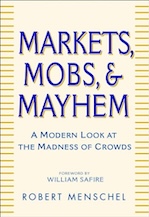Book Summary of Markets, Mobs, and Mayhem- A Modern Look at the Madness of Crowds
by Robert Menschel

What is this book about?
"Markets, Mobs, and Mayhem: A Modern Look at the Madness of Crowds" by Robert Menschel explores the dynamics of crowd behavior, particularly focusing on how it influences financial markets, societal trends, and collective actions. The book delves into historical events and phenomena, such as financial bubbles, rumors, mass panic, and the impact of leaders and followers in shaping the collective mindset. Menschel examines various episodes in history where irrational behavior led to significant economic and social consequences, emphasizing the psychology behind crowd actions and the importance of individual critical thinking.
Who should read the book?
This book is ideal for:
- Investors and Financial Professionals: Those interested in understanding market psychology and the factors that lead to financial bubbles and crashes.
- Sociologists and Psychologists: Individuals who study group behavior, collective actions, and the psychology of crowds.
- Historians: Readers who are fascinated by historical events driven by mass behavior, such as financial panics, booms, and busts.
- General Readers: Anyone interested in the intersection of psychology, history, and finance, and in learning how to avoid the pitfalls of following the crowd blindly.
10 Big Ideas from the Book
- Crowd Behavior Drives Markets: Financial markets are often influenced more by emotions like fear and greed than by rational analysis.
- Historical Bubbles Are Universal: The book reviews numerous historical bubbles, such as Tulipmania and the South Sea Bubble, showing that speculative manias are not new phenomena.
- Rumors and Suggestion: Rumors can rapidly spread within a crowd, leading to irrational decisions and widespread panic.
- Fear and Panic: Collective fear can lead to irrational and destructive behavior, such as stock market crashes or mass sell-offs.
- Violence and Vigilantism: The book explores how crowd behavior can escalate into violence, as seen in historical events like lynchings and riots.
- Leaders and Followers: Charismatic leaders can manipulate crowds, either for good or for ill, by playing on collective emotions.
- Contrarian Thinking: Going against the crowd, or contrarian thinking, is often necessary for individual success in markets and other areas of life.
- Media Influence: The role of the media in amplifying fears and driving crowd behavior is a recurring theme.
- Self-Correction in Markets: Financial markets have a self-correcting nature, often swinging from irrational exuberance to panic.
- Importance of Individual Critical Thinking: The book emphasizes the need for individuals to think critically and independently, rather than succumbing to crowd behavior.
Summary of Markets, Mobs, and Mayhem: A Modern Look at the Madness of Crowds
"Markets, Mobs, and Mayhem" by Robert Menschel is a compelling exploration of crowd behavior and its profound impact on financial markets, societal movements, and historical events. Drawing on a wide range of historical examples, the book delves into how collective emotions like greed, fear, and panic can drive irrational decisions and lead to significant consequences, both economically and socially.
Menschel begins by tracing the origins of financial bubbles, starting with Tulipmania in the 17th century Netherlands. He then examines other infamous bubbles, such as the South Sea Bubble in England and the Mississippi Bubble in France, highlighting the recurring patterns of human behavior that lead to these economic disasters. The book moves beyond financial markets to explore how rumors, fear, and panic can cause chaos in various aspects of society, from stock market crashes to public hysteria during events like the anthrax scare following 9/11.
Throughout the book, Menschel emphasizes the importance of understanding crowd psychology to avoid the pitfalls of following the herd. He advocates for contrarian thinking—making decisions based on independent analysis rather than succumbing to the pressures of mass sentiment. The book is a call to action for individuals to resist the overwhelming influence of crowds and to maintain critical thinking in the face of collective irrationality.
Key Insights
-
The Repetition of Financial Bubbles:
- Financial bubbles are not new; they have occurred throughout history, often following similar patterns. Understanding these patterns can help individuals recognize and avoid future bubbles.
-
The Psychology of Crowds:
- Crowd behavior is often driven by emotions rather than rational thought. When people come together, they tend to act in ways they might not individually, leading to irrational decisions.
-
The Role of Rumors:
- Rumors can spread quickly in a crowd, leading to irrational behavior. In financial markets, rumors can cause sudden spikes or crashes in stock prices.
-
Fear as a Driving Force:
- Fear is one of the most potent forces in crowd behavior. It can lead to panic selling in markets or mass hysteria in society, as seen during events like the Great Depression or the anthrax scare.
-
Contrarian Thinking:
- Menschel advocates for contrarian thinking—going against the crowd. This approach often leads to better outcomes, as crowd-driven decisions are frequently irrational.
-
The Self-Correcting Nature of Markets:
- While markets can swing wildly due to crowd behavior, they tend to self-correct over time. Understanding this can help investors stay calm during market volatility.
-
Media’s Role in Amplifying Crowd Behavior:
- The media plays a significant role in amplifying crowd emotions, whether it’s fear, greed, or panic. Understanding this influence is crucial for making informed decisions.
-
Leadership and Crowds:
- Charismatic leaders can greatly influence crowds, for better or worse. The book discusses how leaders can either exacerbate or calm crowd behavior.
-
The Importance of Historical Perspective:
- Studying historical events of crowd behavior helps in understanding present-day situations. The same psychological mechanisms that drove past bubbles and panics are still at play today.
-
The Power of Independent Thinking:
- Ultimately, Menschel emphasizes the importance of thinking independently. By resisting the influence of the crowd, individuals can make more rational decisions and avoid the pitfalls of mass hysteria.
Relevant Metrics and Key Concepts to Remember
-
Bubble Metrics:
- Price-to-Earnings (P/E) Ratio: High P/E ratios often signal that a market is in a bubble. Menschel illustrates this with examples like the dot-com bubble.
- Market Capitalization: The book discusses how inflated market caps during bubbles are unsustainable and eventually lead to crashes.
-
Herd Behavior:
- Fear and Greed Index: Menschel references this as a measure of market sentiment. High levels of greed often precede market peaks, while high fear levels indicate market bottoms.
-
Contrarian Indicators:
- Volume of Trades: A spike in trading volume, especially during market peaks, can be a sign that a bubble is near its end.
- Short Interest: High short interest might indicate that savvy investors are betting against the crowd, a potential sign of an impending market correction.
-
Psychological Concepts:
- Cognitive Dissonance: The discomfort individuals feel when confronted with evidence that contradicts their beliefs. In markets, this can cause investors to irrationally hold onto losing positions.
- Confirmation Bias: The tendency to seek out information that confirms pre-existing beliefs, often leading to poor decision-making in crowds.
-
Market Dynamics:
- Self-Fulfilling Prophecies: The idea that beliefs held by the crowd can influence the market to behave in a way that fulfills those beliefs, even if they are irrational.
- Moral Hazard: When investors take on excessive risk because they believe they will be bailed out, often seen during bubbles when government interventions are expected.
-
Media Influence:
- Amplification Effect: The concept that media coverage can amplify the effects of rumors, fear, and greed in markets, leading to exaggerated price movements.
Significance of these Concepts
- Bubble Metrics: These help investors identify potential bubbles before they burst, enabling them to make more informed investment decisions.
- Herd Behavior: Understanding herd behavior is crucial for avoiding the pitfalls of following the crowd, which often leads to financial losses.
- Contrarian Indicators: Recognizing contrarian indicators allows investors to capitalize on market inefficiencies and make profits where others are losing.
- Psychological Concepts: Awareness of cognitive biases helps individuals make more rational decisions, both in markets and in other areas of life.
- Market Dynamics: These concepts explain how markets move and why certain patterns repeat, providing a deeper understanding of financial markets.
- Media Influence: Knowing the role of media in shaping market sentiment helps in filtering out noise and focusing on what truly matters for investment decisions.
This comprehensive summary provides a solid foundation for understanding the key themes and lessons from Robert Menschel's Markets, Mobs, and Mayhem. The book serves as a guide for navigating the complexities of crowd behavior in financial markets and beyond, emphasizing the importance of independent thinking and critical analysis.
Which Other Books are Used as References?
The book references several other notable works, including:
- "Extraordinary Popular Delusions and the Madness of Crowds" by Charles Mackay: This classic work is frequently cited for its exploration of historical manias and crowd behavior.
- "The Art of Contrary Thinking" by H.B. Neill: Referenced for its insights into contrarian investment strategies and thinking against the crowd.
- Various works by Rudyard Kipling and Mark Twain: These authors are cited for their observations on human nature, crowd behavior, and leadership.
Browse Summaries of Top Investing books!
You may also like the below Video Courses



